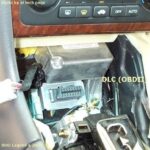Connecting an ELM327 device to your BMW’s OBD2 port unlocks a wealth of information about your vehicle’s performance, health, and hidden features. This article explores how Bmw Obd2 And Elm327 work together to provide diagnostics, data logging, and even coding capabilities for BMW owners.
Understanding BMW OBD2 and ELM327 Compatibility
All BMWs manufactured after 1996 are equipped with an OBD2 port, typically located under the dashboard on the driver’s side. This standardized port allows communication with the vehicle’s Engine Control Unit (ECU) using an OBD2 scanner, such as an ELM327 adapter. The ELM327 acts as a bridge between your BMW’s OBD2 port and your smartphone or laptop, translating complex data into a readable format. While most ELM327 devices are compatible with BMWs, it’s crucial to choose a reliable adapter to ensure stable communication and accurate data. Avoid cheap, unbranded ELM327 clones, especially those marked as version 2.1, as they are known for connectivity issues and potential performance problems in BMWs. Recommended brands include Kiwi 3, Viecar, V-Gate, and Veepeak.
Typical location of the OBD2 port in a BMW
Diagnosing BMW Fault Codes with ELM327
One of the primary uses of an ELM327 with a BMW is to read and clear Diagnostic Trouble Codes (DTCs), also known as fault codes. These codes indicate specific issues within the vehicle’s systems, ranging from minor sensor malfunctions to serious engine problems. When your BMW’s check engine light illuminates, connecting an ELM327 and using a compatible app allows you to retrieve the DTC and its corresponding description, providing valuable insight into the problem. Many OBD2 apps offer extensive DTC databases specifically for BMW models, making diagnosis easier and more accurate. Beyond simply reading codes, some advanced ELM327 software allows you to access live sensor data related to the fault code, facilitating more in-depth troubleshooting.
An ELM327 Bluetooth adapter connected to a smartphone for diagnostics
Unlocking Hidden Features and Performance Data
Beyond basic diagnostics, the ELM327 empowers BMW owners to access a wide array of data and hidden functionalities. Using compatible software, you can monitor real-time engine parameters like RPM, coolant temperature, intake air pressure, and fuel consumption. This data can be used to track performance, identify potential issues before they escalate, and even optimize driving habits for better fuel efficiency. Some BMW models allow for coding using an ELM327 and specialized software. Coding allows you to customize various vehicle settings, activating features that may have been disabled by the manufacturer, such as daytime running lights, automatic door locking, and comfort access features.
Choosing the Right ELM327 Software for BMW
The functionality of your ELM327 device depends heavily on the software you use. Numerous apps and programs are available for smartphones and computers, each offering different features and levels of compatibility with BMWs. Popular options include:
- Torque Pro (Android): A highly customizable app with extensive support for BMW specific PIDs and diagnostics.
- OBD Fusion (iOS and Android): A user-friendly app with support for live data, DTC reading, and some coding capabilities.
- BimmerCode (iOS and Android): Specifically designed for BMW coding and customization.
- INPA/EDIABAS (Windows): Powerful diagnostic and coding software for deeper access to BMW systems, requiring a laptop and specialized K+DCAN cable.
Conclusion: Empowering BMW Ownership with OBD2 and ELM327
The combination of BMW OBD2 and ELM327 technology provides a powerful and affordable way to diagnose problems, monitor performance, and unlock hidden potential in your BMW. By choosing a reliable ELM327 adapter and compatible software, you can gain a deeper understanding of your vehicle and take control of its maintenance and customization. Remember to research and choose reputable software and hardware to ensure a safe and effective diagnostic and coding experience.
A BMW dashboard displaying a warning light, a common reason to use an OBD2 scanner.

